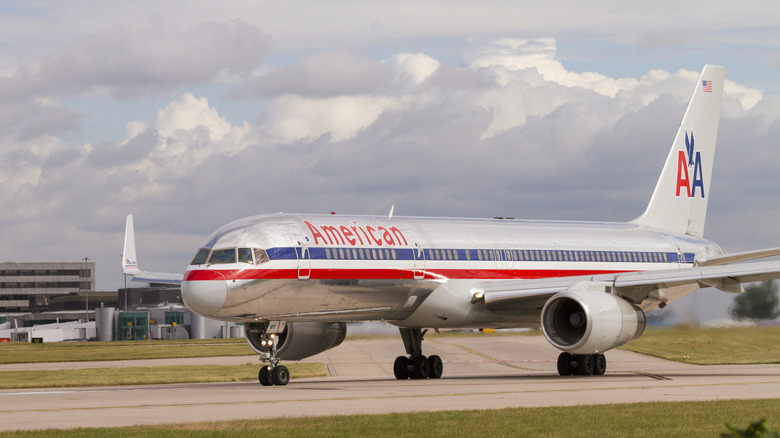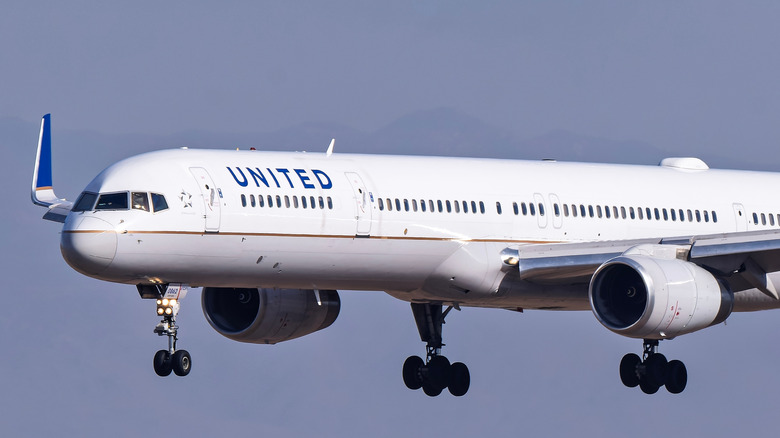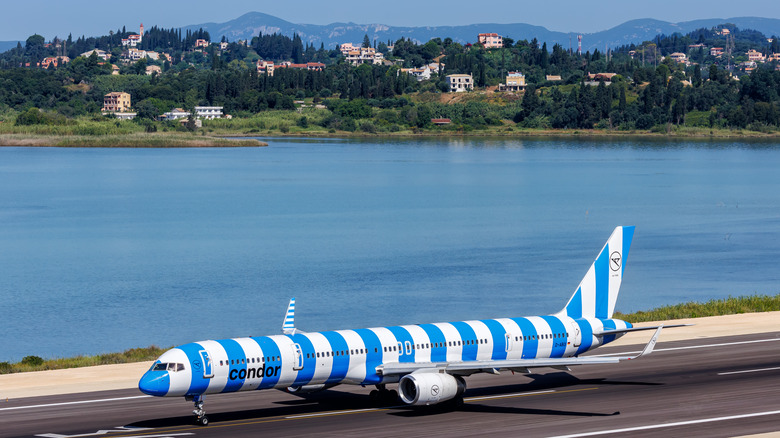Why Is The Boeing 757 Called The 'Flying Pencil?'
It's many people's greatest ambition in life to earn a cool nickname. They need to be earned, after all, as just assigning one to yourself and hoping it sticks just isn't how it works. As a result, you have no control over any nickname given to you, and neither do aircraft. Some popular U.S. military aircraft have great nicknames — the Vought F-8 Crusader came to be known as the Last of the Gunfighters — while others are less than flattering: The same company's F7U Cutlass lacked engine power and was dubbed the Gutless Cutlass as a result.
Nicknames in aviation aren't only used for military aircraft, of course. Civilian planes can often earn a sobriquet from pilots and civilians alike. Boeing proudly boasts of the 747's "Queen of the Skies" nickname, but what of the 757? It has been referred to as the Flying Pencil, and that hardly seems as complementary and majestic-sounding in comparison. Essentially, it's the opposite of the 747, which came to be known as a Jumbo Jet for its sheer size. Perhaps the most iconic wide-body of all time, its predecessor became renowned for putting the narrow in narrow-body.
In this piece, aviation enthusiasts can take a closer look at the slender body of the 757 that earned the nickname, as well as why it was designed that way.
Why Boeing's 757 was designed to be so slender
The Boeing 747 remains a tremendously influential model. Its regal nickname is well earned. There were no wide-body airliners before it was introduced, first taking to the skies early in 1969. The idea behind its manufacture was a perfectly logical one: this was an era of a burgeoning interest in air travel, and if there's one thing you can bet a company will never ignore, it's the clamor of huge numbers of potential customers. As such, it was an economically sound idea to create an aircraft that could accommodate as many people at once — 416 passengers in the case of the 747-400.
Being quite that large isn't always an asset, though. Needless to say, a body this large doesn't lend itself to every airport possible, and so another model would be added to the Boeing repertoire, one that would do what the 747 couldn't and that would serve as a narrow-body counterpart. The 757 would be introduced over a decade later, making its first test flight in February 1982. The following January it began its work, with the first carrier to use it being Eastern Air Lines.
Narrow-body aircraft are considered invaluable for runways and airports that can't accommodate double-row counterparts, but doing so comes at the cost of capacity and range. This isn't to say that the Flying Pencil nickname is a slight on its performance, however.
How the Flying Pencil measures up
From its first incarnation, it was clear that the 757, or 7N7 as it was known early in development, would be a model intended to bridge the gap between the narrow-body and wide-body airliner. With a single aisle as opposed to the latter's two, you might think that a narrow-body could only field half as many travelers, but the intent behind the 757, even early in the design stage, was to carry approximately 239.
It was a bold aim, but one the model family would be equipped for from the beginning. The most logical way to increase the capacity of a single-aisle would be to make it longer, and this is just what was done. The 757-200, the initial model, is 155 feet long and with a wingspan of an impressive 125 feet. Though the 747 is considerably larger, as expected (the 747-8 has a wingspan of 224 feet 5 inches), these dimensions are very sizable for a narrow-body, resulting in an aircraft with a lot of space for passengers facilitated by its long, thin nature.
Perhaps the most notable example of this in the family is the 757-300. As pilot Zak Khogyani noted on Instagram in 2023, this model is "179 feet long (55m) ... the world's longest single-aisle twin-engined jet ever built." As a result, Khogyani explained, ""The Flying Pencil" is what we affectionately call the Boeing 757-300." Affectionately is the operative word, as pilots would love the 757 for several reasons.
What a potent pencil it is too
Flying Pencil isn't the most auspicious nickname. It doesn't convey just what this aircraft was capable of. It transformed what a narrow-body could do, and in the process, had an enormous impact on aviation. It was designed to an extent to replace the 727 passenger jet, which had started commercial flights back in 1964 (also debuting with Eastern Air Lines). Such a move wouldn't have made much sense if the 757 hadn't been a significant upgrade over its predecessor, but it certainly would be.
As the Delta Flight Museum notes, the airline found its 757-200s to have the capacity for 187 customers in comparison to the 148 the 727 could muster, on top of a dramatically improved fuel economy. It was almost 50% more efficient. The broader 757 family would see several variations, of course, with differing characteristics, but it's the added length of the 757-300 specifically that earned it the nickname of Flying Pencil.
Interestingly, it isn't history's only Flying Pencil. Germany also wielded one during World War II. This aircraft was a very different model, a bomber known as the Dornier Do 17. Around 1,500 Dornier 17s were built during the war, and according to the Royal Air Force Museum, "the twin engine, twin fin configuration together with the narrow fuselage and shoulder mounted engines gave the aircraft a distinctive silhouette and earned it the nickname "The Flying Pencil."" In German, this translates to the wonderfully catchy "fliegender Bleistift."



